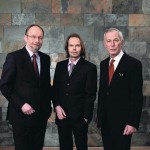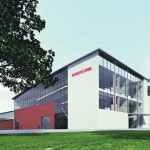Siebtechnik is more successful than ever before. The group has been posting sales increases in double figures for years now. And right on time for the company’s 90th anniversary, the separation specialists have also been awarded an order from China to the tune of 20 million euros. What lies behind this success story? Curious to learn the answers to this and numerous other questions, cpp made its way to Mülheim.
The author: Lukas Lehmann Assistant Editor-in-Chief
cpp: Wilhelm Heinrich Steinhaus established the company that today goes by the name of Siebtechnik GmbH almost 90 years ago. Mr Steinhaus, with which products did your great-grandfather earn his money in those days?
Steinhaus: He worked in Mülheim as a representative of the Dresden firm of Louis Herrmann, which manufactured hurdles, grids and screens made of wire and sheet. Later on, Steinhaus decided to go self-employed. In 1922, he founded his own company, W. Steinhaus & Co. GmbH, which traded both with Louis Herrmann products and with those of other manufacturers. His customers came mainly from the coal mining industry, which was very strongly represented in the region back then.
cpp: When was the company’s name changed to Siebtechnik GmbH?
Steinhaus: That was in 1930. Another impor-tant milestone in Siebtechnik’s history was the ability to produce dewatering centrifuges for fine coal in-house in the years following the Second World War.
cpp: Siebtechnik’s success story is closely linked with the Ruhr coal mining industry. In the meantime, coal mining on the river Ruhr is dead but Siebtechnik continues to reside in Mülheim. What are the reasons for this location?
Steinhaus: Today, our clients operate in many different branches of industry such as chemicals, pharmaceuticals and food, and are distributed throughout the world. What has remained are the people rooted in this region and an outstanding infrastructure. Those are the advantages that have persuaded us to stay.
cpp: What do you mean by outstanding infrastructure?
Steinhaus: Several airports in the vicinity, good motorway access and an integrated network of competent sub-suppliers familiar to us. Even if there is no longer any traditional mining, the Ruhr region is still extremely industrialised with very well-qualified professionals working here.
cpp: Will Mülheim therefore be Siebtechnik’s headquarters in future as well?
Steinhaus: Yes, I assume so. Of course, we meanwhile produce our centrifuges at various locations worldwide. However, Mülheim is and remains Siebtechnik’s competence centre. This is where our research and development department is located and where centrifuges are built for especially complex applications. What’s more, we’re currently planning to erect a new, state-of-the-art production shop for centrifuges – another sign of our commitment to the Mülheim location.
cpp: Does the expansion of your production capacity have anything to do with the gigantic Chinese order?
Bongartz: No, this new centrifuge production shop was in the pipeline anyway. Admittedly, the contract does make comprehensive demands on our know-how and improvisation capability. We usually build a hundred centrifuges a year. The forty for QPP, the potash manufacturer, are in addition to this.
cpp: How big will this new production facility in Mülheim be?
Dietschreit: We will be expanding our existing production facility by about 3000 m2. We hope to start manufacturing on the new premises in the spring of 2013.
cpp: Back to the past. The establishment of Tema in the Netherlands in the thirties was of decisive significance for the development of Siebtechnik. What was the actual background of this company?
Steinhaus: Wilhelm Steinhaus founded Tema, which still has its headquarters in The Hague today, as a vehicle for global sales of his prod-ucts. The company opened the door to the world for him – a bold step at that time which we continue to profit from to this very day. In the history of our firm, there are only a few milestones of comparable significance. I’m thinking here particularly of the founding of Multotec in South Africa, the takeover of Hein Lehmann in 1992 and naturally also our commitment in China.
cpp: Siebtechnik has been active in China since the mid-eighties.
Steinhaus: In 1986, we built the largest sampling plant for coal to date in Qinhuangdao. Tema Siebtechnik Co. Ltd. was established in Ningbo in 2004. Three years later, we moved to Tianjin for capacity reasons. And our commitment in this growth market remains unbroken. We are currently building a new production facility in Wuqing that will commence operation at the end of 2012.
cpp: What will you produce there?
Dietschreit: At present, some 300 Siebtechnik centrifuges are in operation in China. This means we have a huge service obligation. We will be taking this into due account with the new facility. Over and above this, we intend to manufacture parts of our centrifuge range for the Chinese market there.
cpp: How many will be on the Wuqing payroll?
Dietschreit: I anticipate about a hundred jobs.
cpp: Mr. Steinhaus, apart from the commitment in China, you described the establishment of Multotec as a milestone. Why?
Steinhaus: Established in 1973, Multotec is today the largest company in our group with some 1500 personnel. It primarily produces screening plates and wear products for the mining industry in South Africa, South America and Australia.
cpp: In 1992, you took over Hein Lehmann, one of your biggest competitors.
Steinhaus: That’s right. Like us, Hein Lehmann produced screening machines and the screening plates to go with them. They also built centrifuges – though admittedly to a much lesser extent. This takeover is also interesting from a historical viewpoint: in 1947, Hein Lehmann acquired all of Louis Herrmann’s patents and licences, in other words from the company where Wilhelm Steinhaus started his professional career.
cpp: In 1974, Lothar Steinhaus, the nephew of the company founder, handed over the management to your father, Robert Steinhaus. He was responsible for significantly extending the range of centrifuges and steadily strengthening the company’s international activities. You have been representing the founder family in the fourth management generation since 2006. In short, you are filling big shoes. What do you consider to be the key aspects of your work?
Steinhaus: To put it in a nutshell, I would like to avoid a Pareto optimum.
cpp: What do you mean by that?
Steinhaus: Pareto optimum is a term borrowed from mathematics and economics. It describes a situation in which the system parameters are in a state of equilibrium relative to each other. If I alter one parameter, this will automatically lead to the other system parameters worsening. Ultimately, a Pareto optimum is therefore a static state, which – applied to a company – is not conducive to growth.
cpp: With regard to your group of companies, what does this imply?
Steinhaus: Within our group, each general manager works as freely as possible and is fully responsible for his company’s success. Coordination within the group entails the managers cooperating with each other. This means that all the general managers are on a par with one another as they compete for optimum results. I am unable to raise the standing of any one of them without impairing the position of another. I see my remit as being to disrupt this Pareto optimum. In order to tap growth potential and attain the best possible group result – in other words, bring about an overall improvement – it is necessary every now and then for managers to experience a worsening of their situation.
cpp: Instead of harmonious coexistence, you therefore strive for competition between individual managers within the group?
Steinhaus: You could put it like that. On the one hand, I represent this principle through the regular meetings of the group’s general managers as well as in my various capacities in the Stafag holding. On the other hand, as Chief Executive of Steinhaus GmbH, I am also subject to this competition myself. Friction and rivalry are absolutely welcome at our company – both in terms of customers and as a driver of optimum group results.
Hall 5.0, Booth C86
cpp-net.com/0212464
Huge order from China

FACTS & FIGURES
Siebtechnik GmbH is part of the Swiss Stafag Holding AG, to which Steinhaus GmbH, Hein Lehmann Trenn- und Fördertechnik GmbH, Multotec Pty Ltd. and Tema Systems Inc. also belong. The Mülheim enterprise employs 235 staff, of whom just under 45 work in the fields of design and process development.
Siebtechnik can look back on a brilliant year in 2011. “Compared to the previous twelve months, we were able to increase our turnover by 40% to 48.6 million euros”, Karl Bongartz, Chairman of the company’s Executive Board, was pleased to announce. “And 2010 was also a really successful year for Siebtechnik, even if we did then get to feel the initial bank crisis for the first time – due to our long-dated orders.” The separation specialists started the current financial year 2012 with orders in hand to the tune of 23 million euros. In the words of Bongartz, this is a substantial figure for a machine builder. “Not included here is the big Chinese contract valued at 20 million euros which Mr Dietschreit negotiated for us. It concerns the delivery of forty CX 1500 large-scale centrifuges for QPP, the potash manufacturer.”
In the past few years, Siebtechnik have established themselves as well-versed special procedural providers of highly specialised equipment. “We will be further extending this position in future”, explains Bongartz. “Moreover, we would like to offer centrifuges with even higher performance.” Another important point concerning the company’s future orientation is global networking. “This is necessary because the large-scale plant engineering business is charac-terised by worldwide integration. For this reason, we intend to make greater use of the international network Stafag offers us.”
Centrifuges for high throughputs
NEW AT ACHEMA
The relationship between throughput and centrifuge size, wear protection and filter media efficiency – these are three fields of centrifuge technology where Horst Diet-schreit, Siebtechnik GmbH’s Chief Executive, is expecting fundamental changes in the coming years. He explains: “There will be development potential arising from work on concrete projects and – as a result of this – the way we optimise our machines for specific separation tasks”.
The outcome of this development and project work are two machines that Siebtechnik will be presenting at Achema: “Quite fittingly for Siebtechnik’s 90th anniversary, we will be showing the largest worm screen centrifuge in the world, the CX 1500, and a highly efficient separator centrifuge, the screen bowl decanter Tube 1100. The latter model is used in plastics production. Both exhibits have already been sold and will be delivered to the customers concerned after Achema is over.” The third major exhibit can be seen in Frankfurt/Main will be an SHS 902 ZK pusher centrifuge. One important field of application for this machine when used as an alternative to the worm centrifuge is the production of sodium chloride.
Share:








